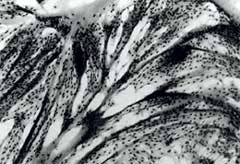Two new techniques of tissue engineering may one day lead to large scale production of lab grown meat that tastes like beef, poultry, pork, lamb or fish and has the texture of meat.

“There would be a lot of benefits from cultured meat,” says Jason Matheny, from the University of Maryland. “For one thing, you could control the nutrients. For example, most meats are high in the fatty acid Omega 6, which can cause high cholesterol and other health problems. With in vitro meat, you could replace that with Omega 3, which is a healthy fat. Cultured meat could also reduce the pollution that results from raising livestock, and you wouldn’t need the drugs that are used on animals raised for meat.”
One of the proposed technique would grow the cells in flat sheets on thin membranes. The sheets of meat would be stretched, then removed from the membranes and stacked on top of one another.
The other method would be to grow the muscle cells on 3D beads that stretch with changes in temperature. The mature cells could then be harvested and turned into a processed meat, like nuggets or hamburgers.
“With a single cell, you could theoretically produce the world’s annual meat supply. And you could do it in a way that’s better for the environment and human health. In the long term, this is a very feasible idea,” says Matheny.
Via Technovelgy UM Newsdesk.
See also The Tissue Culture & Art Project‘s Disembodied Cuisine, an experiment to grow frog muscle over biopolymer for potential food consumption. They even cooked it afterwards and invited people to feast on it.
